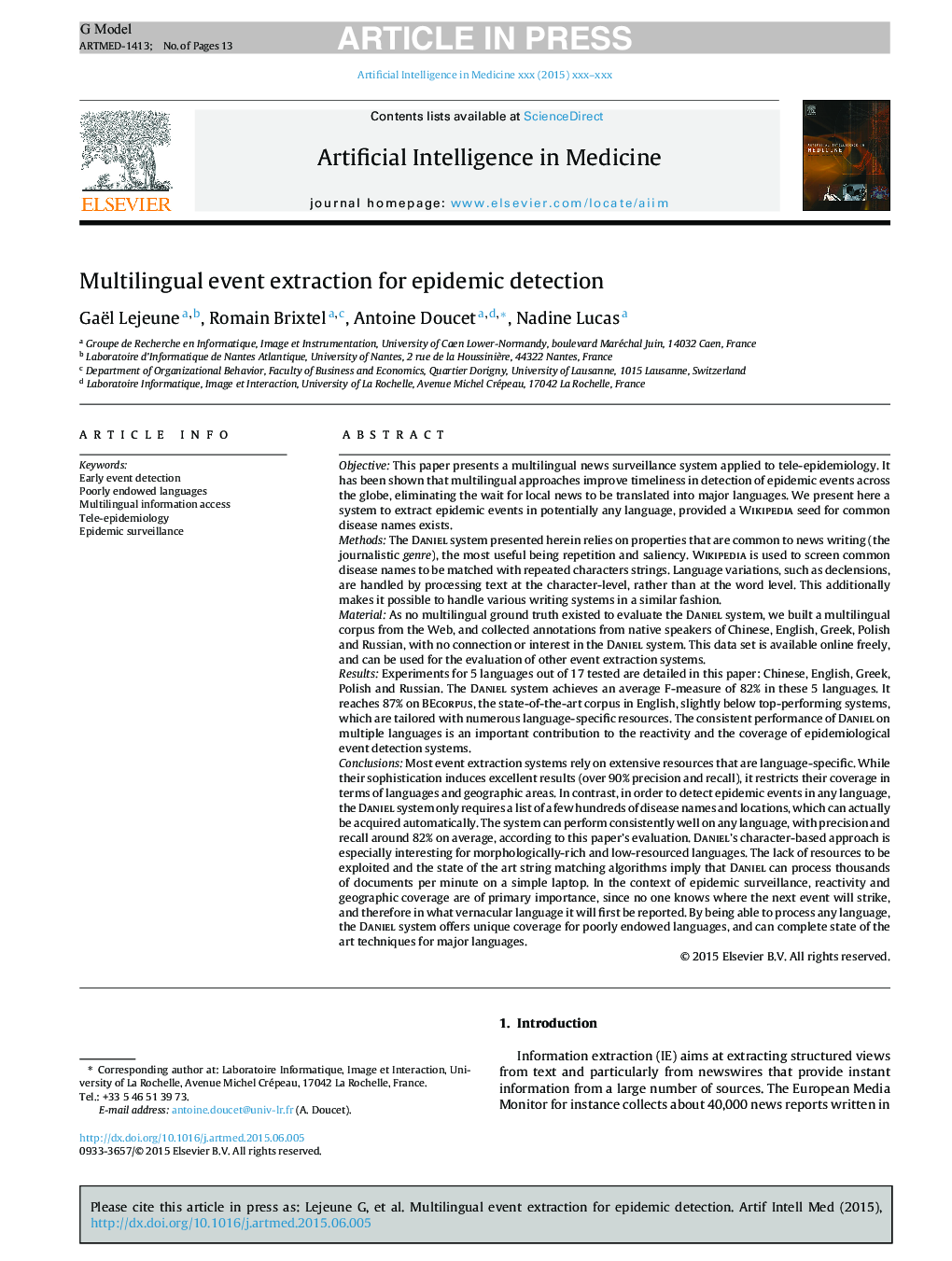| کد مقاله | کد نشریه | سال انتشار | مقاله انگلیسی | نسخه تمام متن |
|---|---|---|---|---|
| 10320527 | 658801 | 2015 | 13 صفحه PDF | دانلود رایگان |
عنوان انگلیسی مقاله ISI
Multilingual event extraction for epidemic detection
ترجمه فارسی عنوان
استخراج رویداد چند زبانه برای تشخیص اپیدمی
دانلود مقاله + سفارش ترجمه
دانلود مقاله ISI انگلیسی
رایگان برای ایرانیان
کلمات کلیدی
تشخیص زود هنگام، زبان های ناکافی، دسترسی به اطلاعات چند زبانه، تله اپیدمیولوژی، نظارت بر اپیدمی،
ترجمه چکیده
اکثر سیستم های استخراج رویداد به منابع گسترده ای وابسته هستند که خاصیت زبان دارند. در حالی که پیچیدگی آنها باعث نتایج عالی (بیش از 90٪ دقت و فراخوانی)، پوشش آنها را از لحاظ زبان ها و مناطق جغرافیایی محدود می کند. در مقابل، برای شناسایی رویدادهای اپیدمی در هر زبان، سیستم دانیل فقط یک لیست از چند صدها نام و مکان بیماری را که به طور خودکار می تواند به دست آورد، مورد نیاز باشد. با توجه به ارزیابی این مقاله، این سیستم می تواند به طور صحیح در هر زبانی با دقت و به طور متوسط حدود 82٪ به طور مداوم به انجام برساند. رویکرد مبتنی بر شخصیت دانیل به ویژه برای زبان مورفولوژیکی غنی و کم منابع بسیار جالب است. فقدان منابع مورد بهره برداری و الگوریتم های منطبق با رشته هنر، به این معنی است که دانیل می تواند هزاران اسناد را در هر دقیقه در یک لپتاپ ساده پردازش کند. در چارچوب نظارت اپیدمی، واکنش پذیری و پوشش جغرافیایی اهمیت اساسی دارند، زیرا هیچکس نمی داند که رویداد بعدی اعتصاب خواهد کرد و بنابراین در چه زبان اولیۀ زبان بومی است. با داشتن توانایی پردازش هر زبان، سیستم دانیل ارائه پوشش منحصر به فرد برای زبان های ضعیف ارائه می دهد و می تواند حالت تکنیک های هنر برای زبان های اصلی را کامل کند.
موضوعات مرتبط
مهندسی و علوم پایه
مهندسی کامپیوتر
هوش مصنوعی
چکیده انگلیسی
Most event extraction systems rely on extensive resources that are language-specific. While their sophistication induces excellent results (over 90% precision and recall), it restricts their coverage in terms of languages and geographic areas. In contrast, in order to detect epidemic events in any language, the Daniel system only requires a list of a few hundreds of disease names and locations, which can actually be acquired automatically. The system can perform consistently well on any language, with precision and recall around 82% on average, according to this paper's evaluation. Daniel's character-based approach is especially interesting for morphologically-rich and low-resourced languages. The lack of resources to be exploited and the state of the art string matching algorithms imply that Daniel can process thousands of documents per minute on a simple laptop. In the context of epidemic surveillance, reactivity and geographic coverage are of primary importance, since no one knows where the next event will strike, and therefore in what vernacular language it will first be reported. By being able to process any language, the Daniel system offers unique coverage for poorly endowed languages, and can complete state of the art techniques for major languages.
ناشر
Database: Elsevier - ScienceDirect (ساینس دایرکت)
Journal: Artificial Intelligence in Medicine - Volume 65, Issue 2, October 2015, Pages 131-143
Journal: Artificial Intelligence in Medicine - Volume 65, Issue 2, October 2015, Pages 131-143
نویسندگان
Gaël Lejeune, Romain Brixtel, Antoine Doucet, Nadine Lucas,
